Dal Tadka is a popular Indian lentil dish made with cooked arhar dal (husked & split pigeon pea lentils) or masoor dal (husked & split red lentils) mixed with a flavorful aromatic tempering (tadka) of spices like cumin, garlic, red chillies, asafetida and herbs in oil or ghee. This Dal Tadka recipe gives you a delicious creamy dal with smoky flavors.
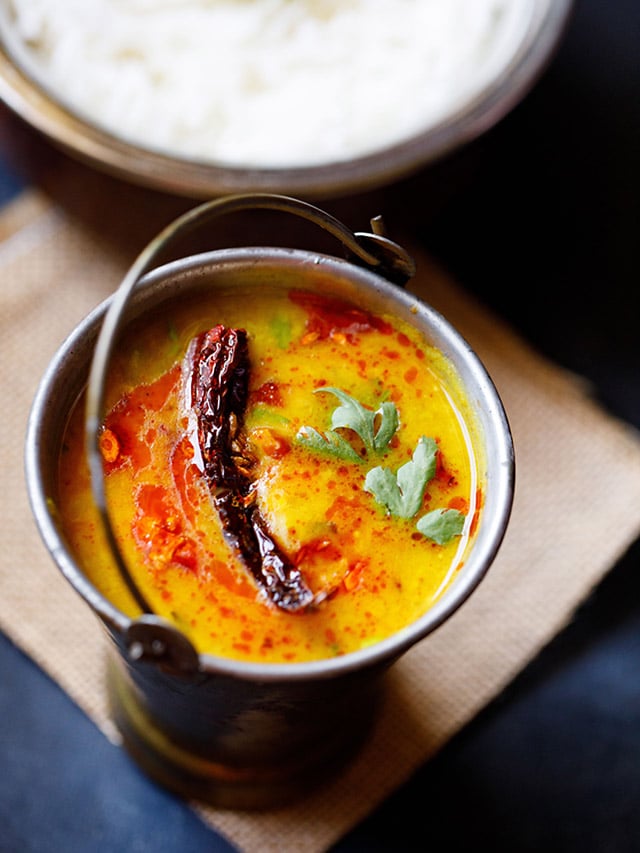
In this post I am sharing 2 versions of the recipe.
- Restaurant Style Dal Tadka – Made on Stovetop with an optional smoking method.
- Home Style Dal Tadka – Made in the Instant Pot.
Both the recipes are easy and taste good. You can make either of them as per your preference. For making homestyle dal tadka on stovetop, check the notes section in the recipe card of instant pot dal tadka recipe.
Table of Contents
About This Recipe
Dal Tadka is one of the most popular lentil dish served in Indian restaurants. Basically, dal tadka is cooked lentils which are tempered with oil or ghee fried spices & herbs.
I have to admit that I simply love the dal tadka that is served at the restaurants even though we hardly eat out.
So I try to recreate the restaurant magic in most of the food that I make at home. Here the restaurant style flavors come from smoking the dal using a red-hot charcoal.
Trust me, this simple method of smoking makes the dal so much flavorful and tasty. In Hindi language we also call this smoking technique as dhungar.
This Dal Tadka recipe is more of a North Indian style recipe.
What does Dal Tadka mean?
- Dal is the Hindi term for lentils.
- Tadka or Chaunk is the Hindi term for tempering and is a commonly employed cooking technique in the Indian cuisine.
- Tempering method has the spices & herbs fried in oil. The frying of the spices and herbs release their essential oils, aroma and flavor in the hot oil. This fried spices, herbs, oil mixture is added to prepared lentils or cooked rice or steamed vegetables and it greatly changes the flavor, aroma and taste of the dish. Tempering is very much a part of cooking Indian food and we use this method while making dal, vegetable dishes or chutneys.
Lentils Included
- Tuvar dal – Generally dal tadka is made with tuvar dal or arhar dal also known as split pigeon pea lentils. In this post, I have shared the dal recipe made with tuvar dal.
- Moong dal – Even moong lentils can be used to make the recipe. At times I make this recipe both with tuvar dal and moong dal. The recipe can also be made with a mix of masoor dal (red lentils) and pigeon pea lentils. If you want to use moong dal then you can refer this post – Moong Dal Tadka.
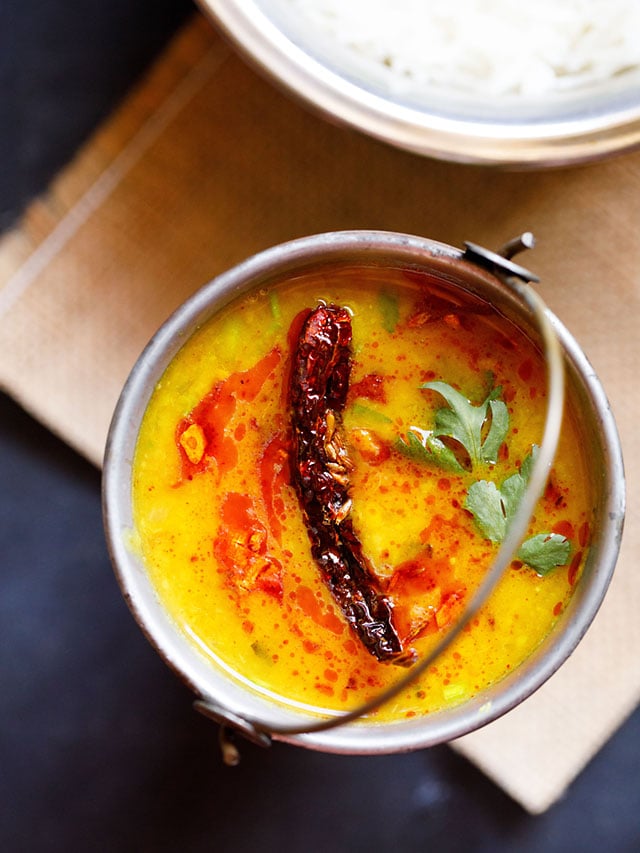
How to make Dal Tadka
1. Rinse 1 cup tuvar dal or arhar dal (split & husked pigeon pea lentils) for a couple of times in water. Add them to a 3 litre pressure cooker.
You can also cook the lentils in a pot. Soak the lentils for an hour or two before you cook them in a pot. The method on cooking lentils in a pot is mentioned in the notes section of the recipe card below.
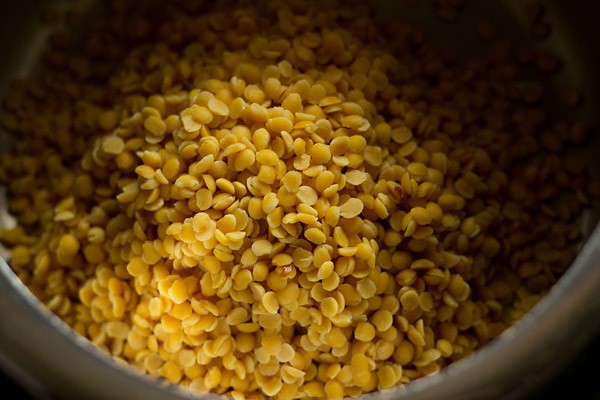
2. Add ½ cup chopped onions, 1 cup finely chopped tomatoes, 1 or 2 green chilies (1 teaspoon of chopped Anaheim pepper or Serrano pepper can be subbed for green chillies) and 1 teaspoon finely chopped ginger.
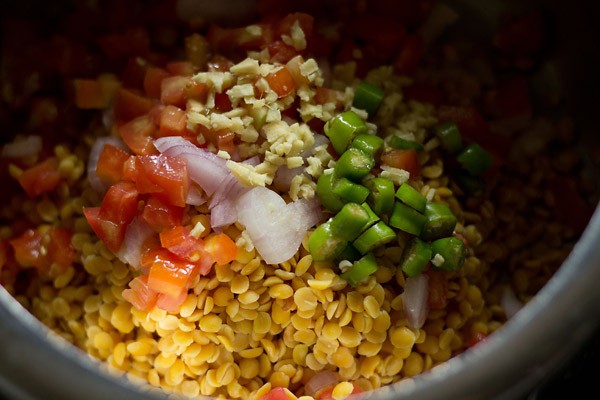
3. Pour 2.5 cups of water. If cooking in a pot, then about 4 to 4.5 cups of water can be added.
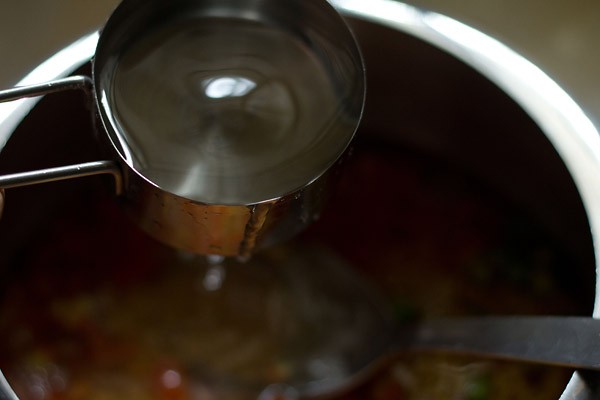
4. Add ½ turmeric powder and 1 pinch of asafoetida (hing). If you do not have asafoetida, then skip it.
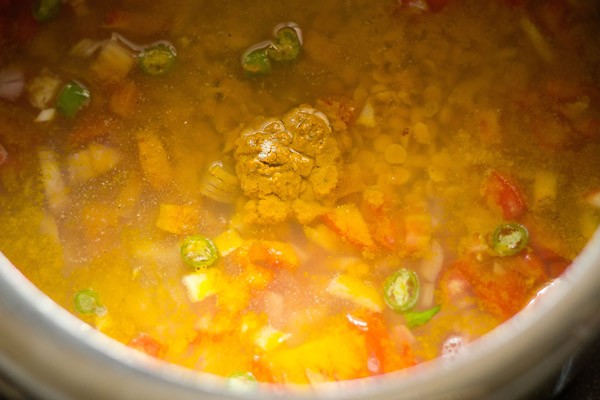
5. Mix well.
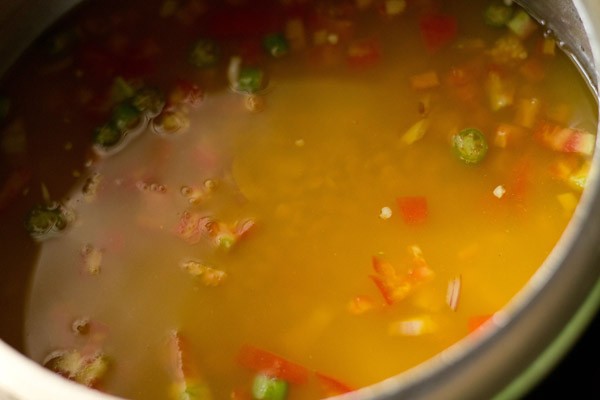
6. Pressure cook the lentils for about 7 to 8 whistles or more till they become soft and creamy. Mash the cooked lentils with a wired whisk or with a spoon and keep aside.
If the consistency looks thick, then add some water. About ½ cup to 1 cup water (depending on the thickness) to get a medium consistency. Simmer dal for 3 to 4 minutes. Consistency of the lentils in the below photo.
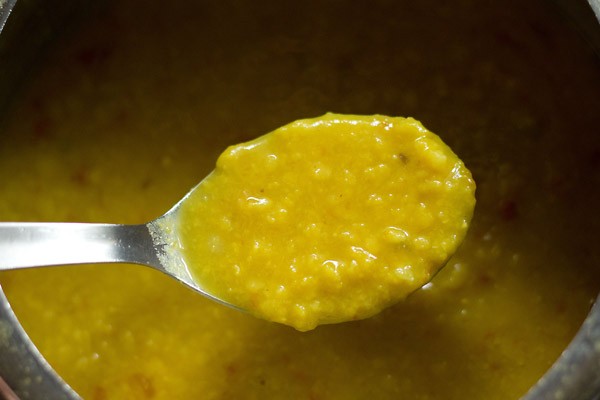
7. Once the desired consistency is reached, add 1 to 2 tablespoons low-fat cream (optional), ½ teaspoon garam masala powder, 2 tablespoons chopped coriander leaves (cilantro) and salt as per paste. Switch off the the heat.
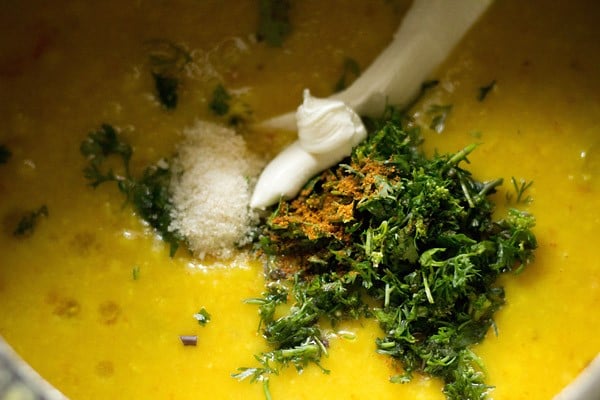
8. Mix well so that everything combines uniformly. Check the salt before you add the tempering. If the salt is less than add more salt to the dal.
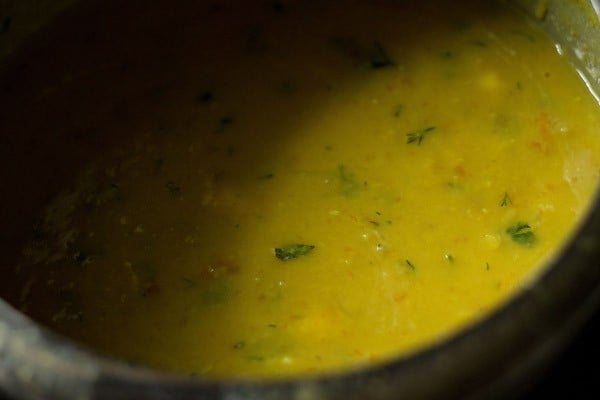
9. The final consistency of the cooked dal.
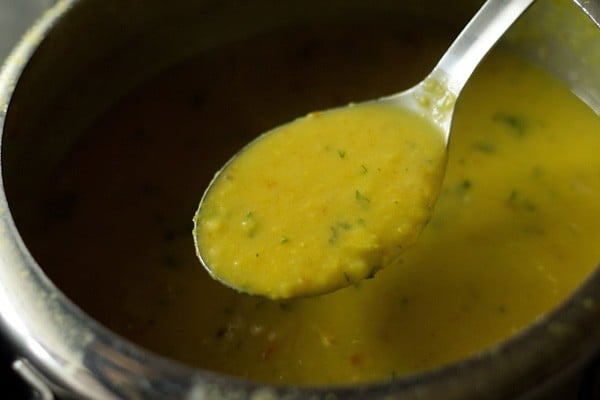
Optional – smoking or dhungar method
10. Next is the dhungar method of flavoring dal tadka with the smoky fumes of burnt charcoal. For this with the help of tongs or on a grill pan like shown in the photo below, place a small piece of charcoal.
Burn the charcoal till it becomes red hot. Please use natural charcoal for this method. Note that this is an optional step and you can proceed directly to the tempering method.
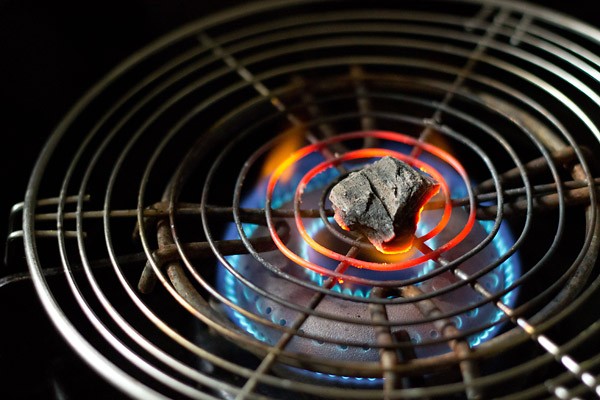
11. Place the red hot charcoal in a small steel bowl. You can also use onion layers or a halved hollow onion for the same.
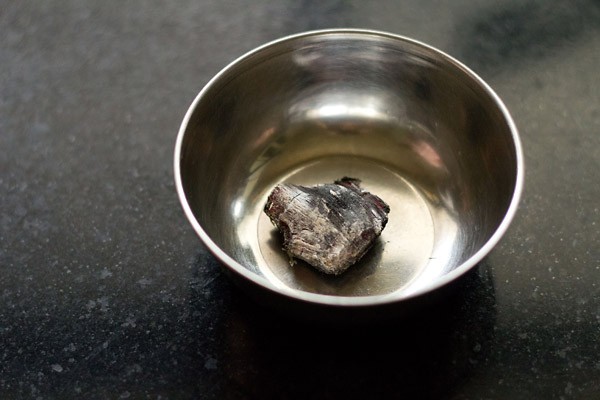
12. Pour about ¼ tsp of oil or ghee on the charcoal. You will see fumes emanating as soon as you pour oil or ghee on the hot charcoal.
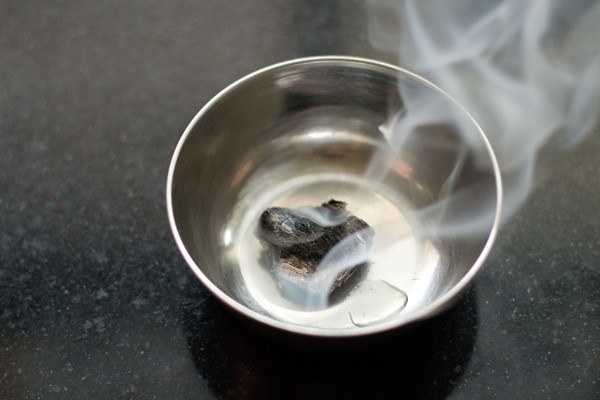
13. Place this bowl on the dal.
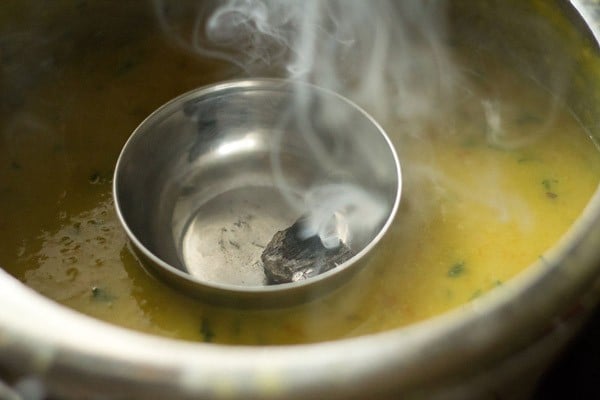
14. Cover the cooker or the pot with a lid and let the dal get infused with the charcoal smoke. Just keep for 1 to 2 minutes.
Do not keep for a long time as then the dal can taste bitter. Remove the bowl carefully with the help of tongs and cover the cooker with a lid. Set aside.
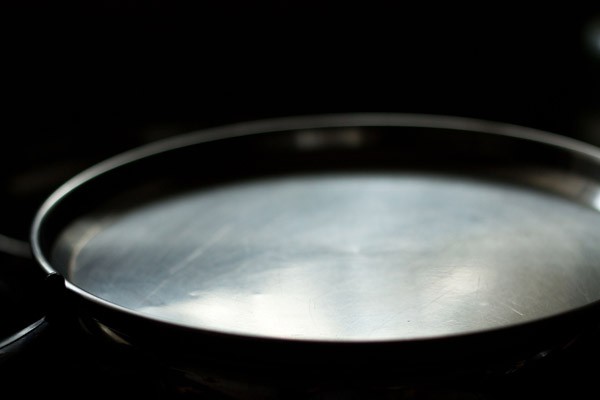
Making tempering or tadka
15. Next heat 3 tablespoons oil or ghee (clarified butter) in a small pan. First, add 1 teaspoon cumin seeds and crackle them. The cumin should get fried and not be raw, but don’t burn them.
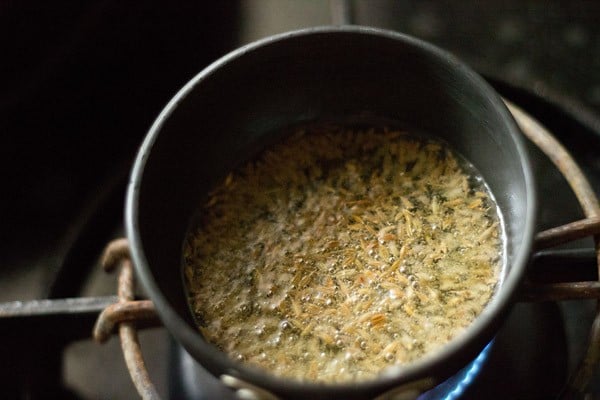
16. Now add 2 to 3 dry red chilies, a generous pinch of asafoetida and 5 to 6 medium sized garlic cloves which have been finely chopped. Let the garlic brown and the red chilies change color. Do not burn the garlic.
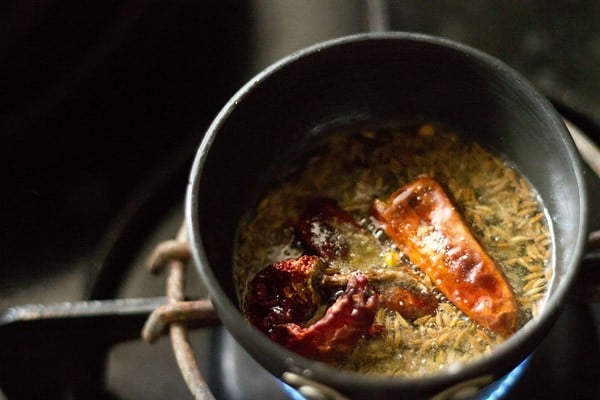
17. Lastly add 1 teaspoon crushed kasuri methi and ½ teaspoon red chili powder or cayenne pepper. Mix and switch off the stove. Make sure to fry the tempering ingredients at a low flame, so that you don’t burn them.
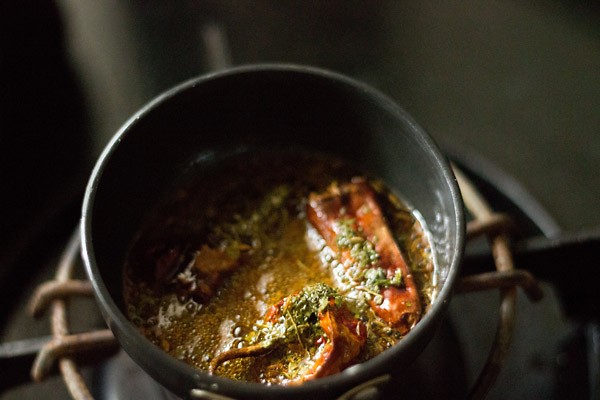
18. Pour entire tempering along with the oil or ghee into the dal.
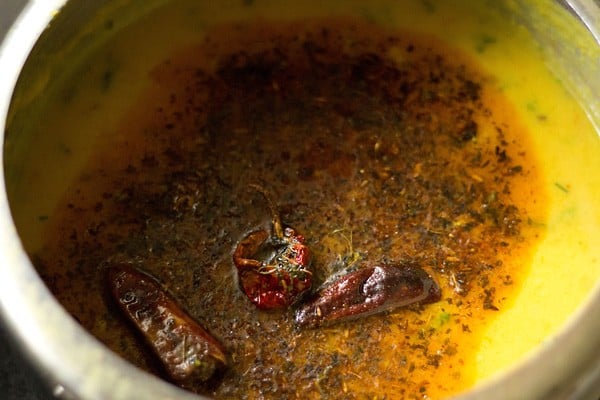
19. You can mix the dal with tempering or serve the dal tadka with the tempering on top it. Garnish with coriander leaves. Serve it hot with steamed basmati rice, cumin rice or with Indian flatbread like roti or paratha or chapati or naan.
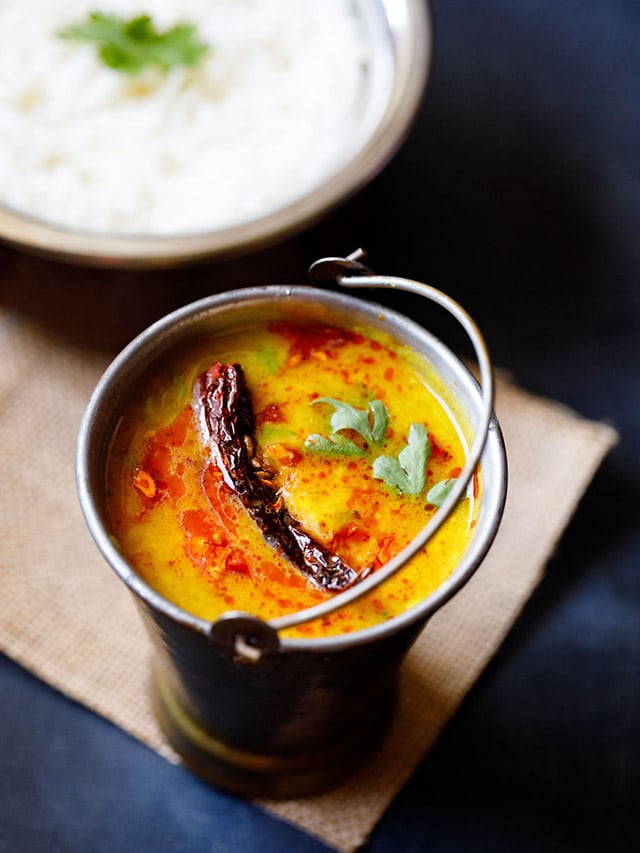
Serving Suggestions
The tempering adds a lot of flavor, aroma and thus the dal tadka gets paired beautifully with steamed rice or jeera rice (cumin flavored pilaf).
Dal tadka can be also be served with roti or naan or dinner rolls or paratha.
Expert Tips
- Preparation: First, cook the lentils and then lastly temper it just before serving. You can also cook the lentils first and keep in the fridge. Before serving reheat the lentils and then temper it. Serve immediately. However for best taste always prepare the lentils fresh. It not only tastes good but also a healthier choice.
- Type of Lentils: You can make it with any yellow dal (split lentils). I make it sometimes with Tuvar dal (split pigeon pea lentils) and Masoor dal (split pink lentils) and sometimes only with Tuvar dal.
- Tomatoes: I have added tomatoes and it gives a nice tang. If you do not have tomatoes, then add ½ to 1 teaspoon of lemon juice when the lentils are cooked.
- Tempering: You can temper or fry the spices and herbs in either ghee or oil. In the recipe I have used sunflower oil but ghee (clarified butter) also gives a good flavor. You can even use peanut oil or any neutral flavored oil.
- Dhungar Method: In the step by stepwise photos below, I have illustrated the charcoal smoking method as it gives a really good smoky flavor to the lentils. You can easily skip this method if you don’t have charcoal. Another alternative to get that smoky flavor is to add smoked paprika instead of red chilli powder or cayenne pepper.
- Consistency: The consistency of the cooked dal is neither thick nor thin but medium. But if you prefer you can opt for a slightly thick or thin dal consistency.
- Soaking Lentils: You can also soak the lentils for 30 to 40 minutes before cooking them. This helps in cooking the lentils faster and a recommended step.
Dal is a staple in Indian food. India has so many varieties of dal recipes. Each region, each state having their own delicious recipes.
More Popular Dal Recipes
Dal (Lentils) & Legumes
Dal (Lentils) & Legumes
Dal (Lentils) & Legumes
Dal (Lentils) & Legumes
Please be sure to rate the recipe in the recipe card or leave a comment below if you have made it. For more vegetarian inspirations, Sign Up for my emails or follow me on Instagram, Youtube, Facebook, Pinterest or Twitter.
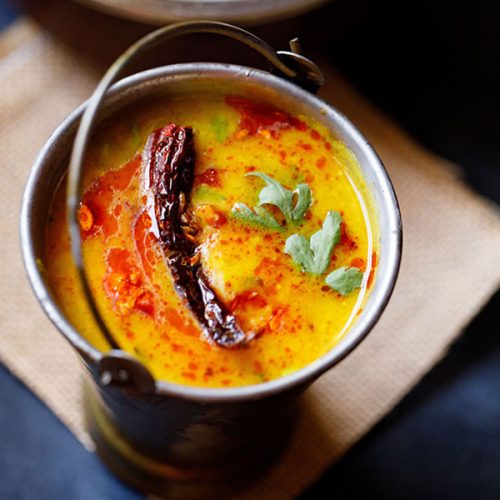
Restaurant Style Dal Tadka Recipe
Ingredients
for cooking lentils
- 1 cup tuvar dal (arhar dal or split pigeon pea lentils) or 200 grams or ½ cup tuvar dal + ½ cup masoor dal (split pink lentils)
- 1 to 2 green chilies or serrano peppers – chopped or slit lengthwise
- ½ cup chopped onions or 1 medium sized onion
- 1 cup finely chopped tomatoes or 2 medium sized tomatoes
- 1 teaspoon finely chopped ginger or 1 inch ginger, peeled and finely chopped
- ½ teaspoon turmeric powder (ground turmeric)
- ½ teaspoon Garam Masala
- 1 pinch asafoetida (hing) – optional
- 2.5 cups water – for pressure cooking
- 1 or 2 tablespoon low-fat cream – optional
- 2 tablespoon chopped coriander leaves (cilantro)
- salt as required
for tempering or tadka
- 3 tablespoon oil or 3 tablespoon ghee (clarified butter)
- 1 teaspoon cumin seeds
- 5 to 6 medium garlic cloves – finely chopped
- 2 to 3 dry red chilies – broken and seeds removed
- a generous pinch of asafoetida (hing) – optional
- 1 teaspoon crushed kasuri methi (dry fenugreek leaves) – optional
- ½ teaspoon red chili powder or cayenne pepper or paprika
for garnish
- 1 tablespoon chopped coriander leaves (cilantro)
for dhungar method
- a small piece of charcoal
- ¼ teaspoon oil or ghee (clarified butter)
Instructions
1. cook lentils
- 1. Thoroughly rinse 1 cup tuvar dal (arhar dal, or split & husked pigeon pea lentils) in water. Add them to a 3-litre pressure cooker.No pressure cooker? You can also cook the lentils in a pot. Soak the lentils for an hour or two before you cook them in a pot.
- 2. Add ½ cup chopped onions, 1 cup finely chopped tomatoes, 1 or 2 green chilies (1 teaspoon of chopped Anaheim pepper or Serrano pepper can be subbed for green chillies) and 1 teaspoon finely chopped ginger.
- 3. Pour 2.5 cups of water into the pressure cooker. If cooking in a pot, then about 4 to 4.5 cups of water can be added.
- 4. Add ½ turmeric powder and 1 pinch of asafoetida (hing). If you do not have asafoetida, then skip it. 5. Mix well.
- 6. Pressure cook the lentils for about 7-8 whistles, or until they become soft and creamy. Mash the cooked lentils with a wired whisk or with a spoon and keep aside. If the consistency looks thick, then add about ½ – 1 cup water (depending on the thickness) to get a medium consistency. Simmer dal for 3 to 4 minutes.
- 7. Once the desired consistency is reached, add 1-2 tablespoons low-fat cream (optional), ½ teaspoon garam masala powder, 2 tablespoons chopped coriander leaves (cilantro) and salt to taste. Switch off the the heat.
- 8. Mix well so that everything combines uniformly. Taste and adjust salt before adding tadka.
2. Smoke lentils using dhungar method (optional)
- 10. To get the smoky fumes of burnt charcoal like you would in a restaurant, you'll want to follow the dhungar method. Using tongs, place a small piece of charcoal on a grill pan like shown in the photo below. Burn the charcoal till it becomes red hot. Please be sure to use natural charcoal for this method, avoiding anything that has a flame accelerant added. Note that this is an optional step – you can proceed directly to the tempering method.
- 11. Place the red hot charcoal in a small steel bowl. You can also use a halved hollow onion instead of the bowl.
- 12. Pour about ¼ tsp of oil or ghee on the charcoal. You will see fumes emanating as soon as you pour oil or ghee on the hot charcoal.
- 13. Place this bowl on the dal.
- 14. Cover the cooker or pot with a lid and let the dal get infused. Only smoke for 1-2 minutes. Do not keep for a long time, or you'll risk making the dal taste bitter. Remove the bowl carefully with the help of tongs and cover the cooker with a lid. Set aside.
make the tempering (tadka or chaunk)
- 15. Next, heat 3 tablespoons oil or ghee (clarified butter) in a small pan over low-medium heat. First, add 1 teaspoon cumin seeds and crackle them. The cumin should get fried and not be raw, but be careful not burn them.
- 16. Now add 2 to 3 dry red chilies, a generous pinch of asafoetida, and 5-6 medium sized garlic cloves which have been finely chopped. Let the garlic brown lightly and the red chilies change color. Do not burn the garlic.
- 17. Lastly, add 1 teaspoon crushed kasuri methi (fenugreek seeds) and ½ teaspoon red chili powder or cayenne pepper. Mix well and turn off the stove.
- 18. Pour entire tempering along with the oil or ghee into the dal.
- 19. You can either mix the dal with tempering, or serve the dal tadka with the tempering on top it. I personally like the aesthetic of having the tadka floating on top. Garnish with coriander leaves. Enjoy!
- Serving Suggestion: Serve dal tadka hot with steamed basmati rice or jeera rice (cumin rice), or with roti, naan or paratha.
Video
Notes
- Type of Lentils: You can make the recipe with any yellow dal (split lentils). I make it sometimes with Tuvar dal (split pigeon pea lentils) and Masoor dal (split & husked red lentils) and sometimes only with Tuvar dal. You can even add an equal mix of tuvar dal and moong dal.
- Soaking Lentils: You can also soak the lentils for 30 to 40 minutes before cooking them.
- Tomatoes: I have added tomatoes and it gives a nice tang. If you do not have tomatoes, then add ½ to 1 teaspoon of lemon juice when the lentils are cooked.
- Tempering: You can temper or fry the spices and herbs in either ghee or oil. In the recipe I have used sunflower oil but ghee (clarified butter) also gives a good flavor. You can even use peanut oil or any neutral flavored oil.
- Dhungar Method: You can easily skip the charcoal smoking method if you don’t have charcoal. Another alternative to get that smoky flavor is to add smoked paprika instead of red chilli powder or cayenne pepper.
- Consistency: The consistency of the cooked dal is neither thick nor thin but medium. But if you prefer you can opt for a slightly thick or thin dal consistency.
- Soaking Lentils: You can also soak the lentils for 30 to 40 minutes before cooking them. This helps in cooking the lentils faster and a recommended step.
- Soak the lentils for about 1 to 2 hours. Drain and rinse then well in water.
- In a deep pot, add 4 to 5 cups water added to the lentils. Add the rest of the ingredients mentioned in the recipe.
- Cover and cook the lentils. If the water begins to froth and bubble, then remove the lid or cover it partly and continue to cook the lentils till they become soft and creamy.
- If the water becomes less, then add some hot water.
- Once the lentils are cooked (takes from 45 minutes to an hour or sometimes more (depends on the quality and age of the lentils). Then follow the recipe further.
Nutrition Info (Approximate Values)
About Instant Pot Dal Tadka
Dal is a staple at home and I make them in different varieties. What I am sharing in this post, is a version that has been made for decades and is still being made.
A family recipe and one which I make often. A comforting and nourishing dal recipe which I hope you enjoy as much as we do. This is a vegan recipe and can be made gluten-free by skipping asafoetida.
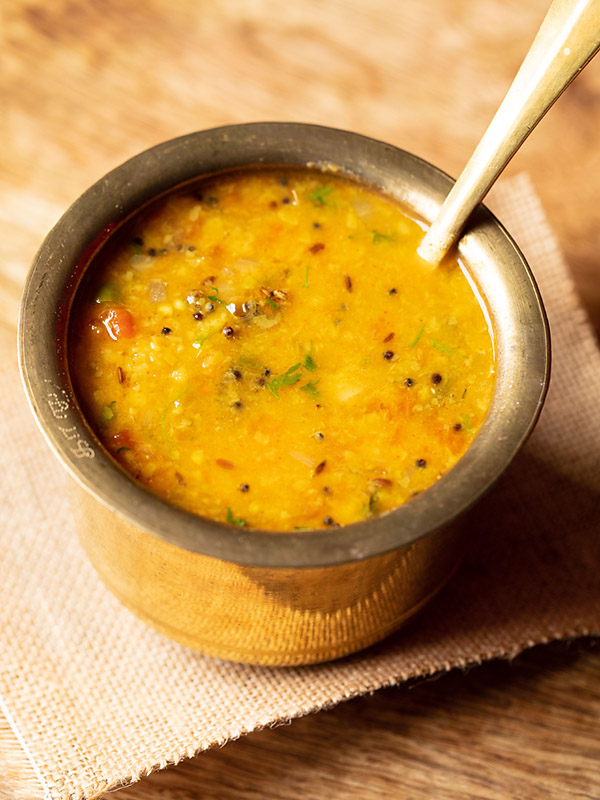
There are many variations of making dal tadka. This instant pot recipe is a home-style version and tastes good like an everyday home cooked food.
After getting the instant pot, I have been making dal in it. I have stopped using the stove-top pressure cooker completely. Thus I have updated this post with the instant pot method also. I have included the stovetop method of this homestyle dal tadka in the recipe card.
At times I even cook the rice along with the dal. I usually serve this dal tadka with roti (Indian flatbread) or steamed rice. So when making rice, I cook the rice and dal together in the IP.
It is best served with some steamed basmati rice. You can also serve with chapati or roti or dinner rolls.
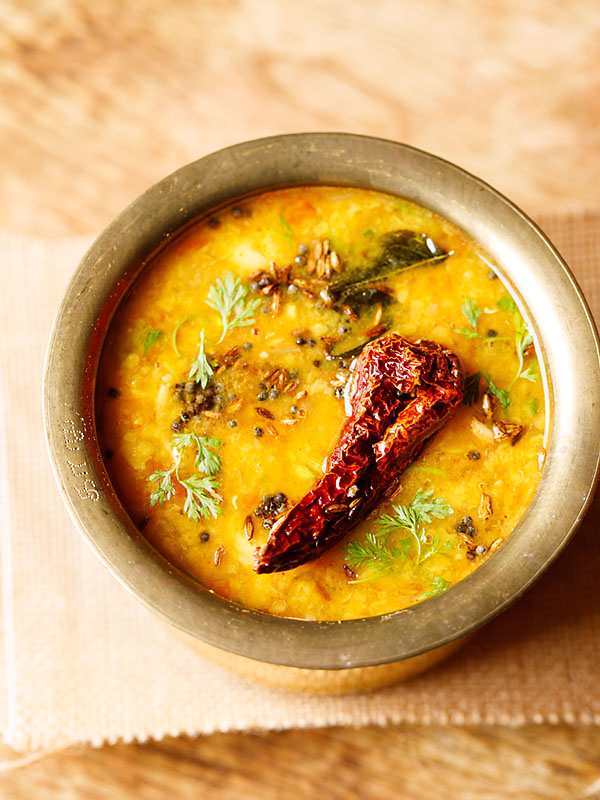
Step by Step Instant Pot Dal
1. Take ½ cup arhar dal (tuvar dal or pigeon pea lentils) in a bowl or colander.
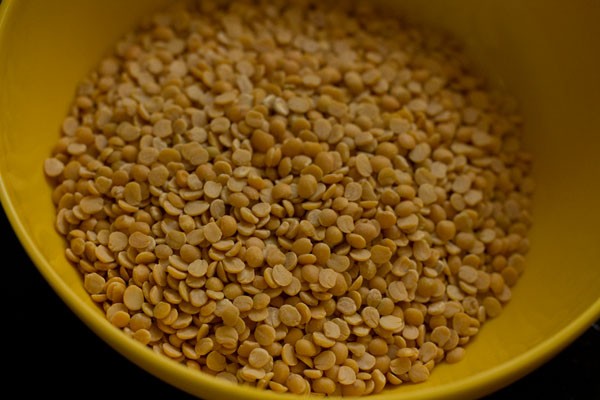
2. Rinse a couple of times and add the rinsed dal in the instant pot steel insert.
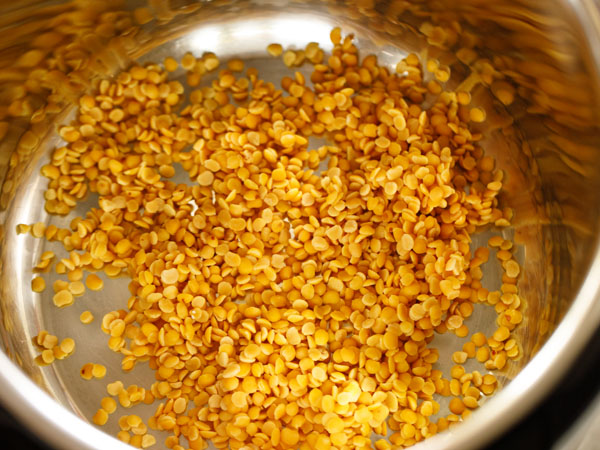
3. Add ⅓ heaped cup sliced onions, ⅓ cup chopped tomatoes, 2 green chillies or serrano peppers (sliced, slit or chopped).
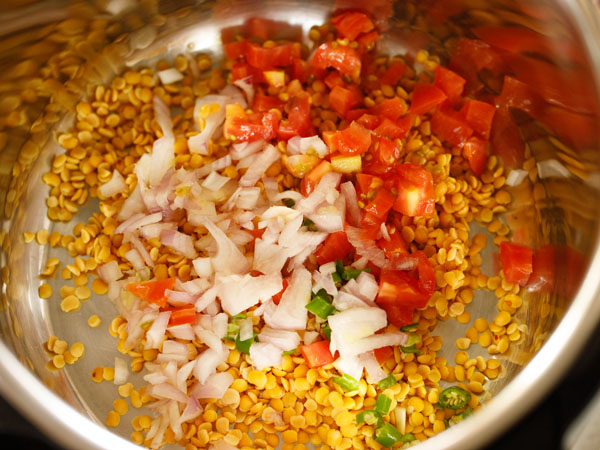
4. Add ½ tsp turmeric powder, ½ tsp Kashmiri red chilli powder and a pinch of asafoetida (hing).
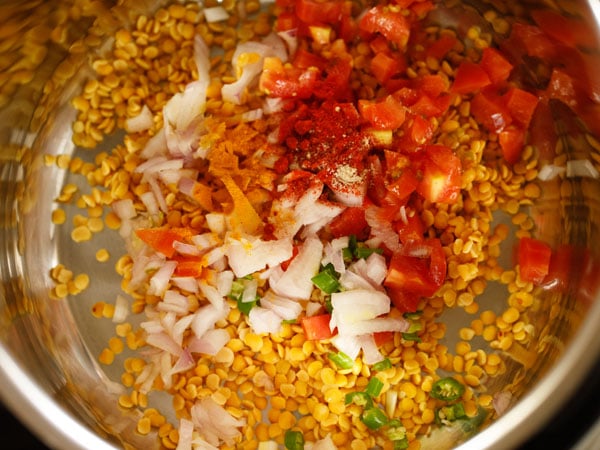
5. Pour 1.5 cup water. Mix well.
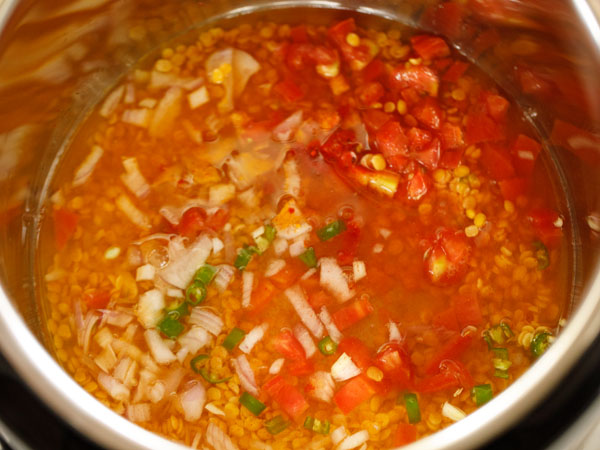
6. Mix very well. At this step if you plan to cook rice, then place a tall trivet and add rice+water in a steaming pan. Place the pan on the trivet.
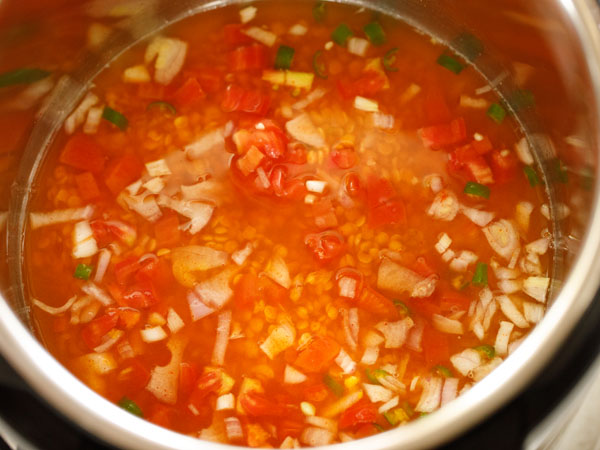
7. Switch on the IP. Secure the lid and position the steam release handle to sealing. Press the pressure cook button and set the timer for 15 minutes on high pressure.
Depending on the quality and age of lentils, it can take 10 to 15 minutes. I prefer the dal to be cooked really well and mushy without any separate grains visible, so I cook the lentils for 15 minutes.
At times I have even cooked the lentils for 20 minutes. So depending on the quality of dal, you can decide upon the timing. Anyways, even if the lentils are undercooked, you can always pressure cook for some more minutes later.
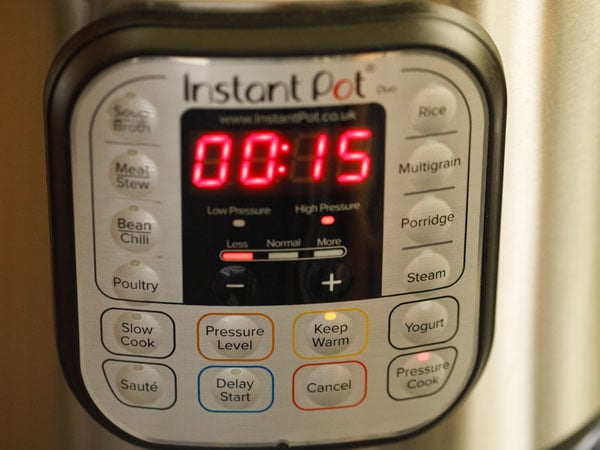
8. Give NPR (natural pressure release) after 10 minutes. Release the pressure after 10 minutes and open the IP lid. The lentils have to be cooked very well and become soft and mushy.
If the consistency of dal looks thick, then add some hot water to thin it. If dal looks thin, then use the sauté option and simmer dal for a few minutes.
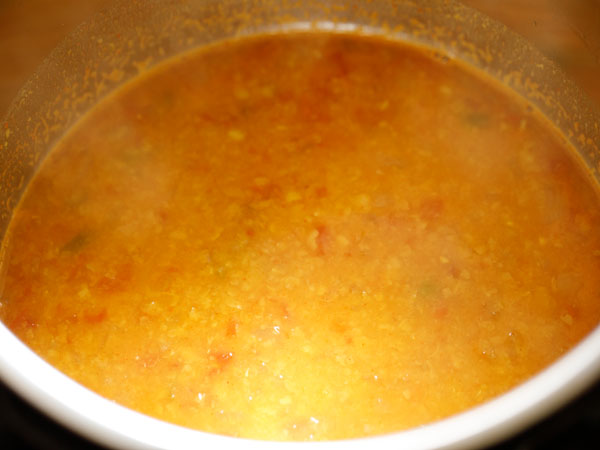
9. With a spoon lightly mash the dal. If the dal looks thick, you can add some hot water.
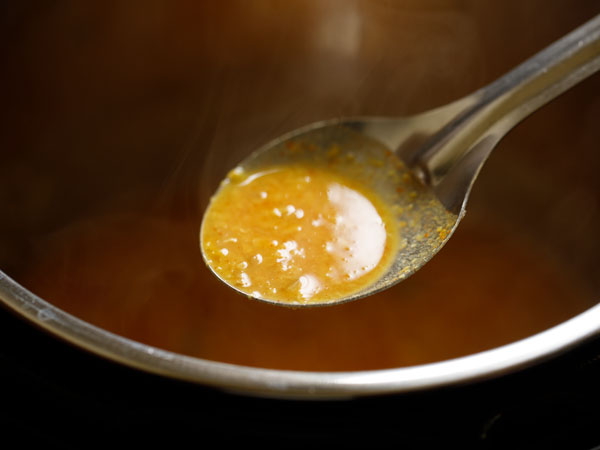
10. Season with salt as per taste and stir very well. Cover the cooked dal with the IP lid and begin with the tempering
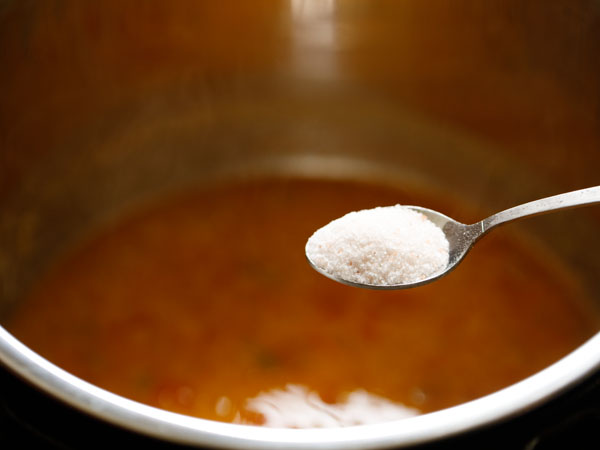
Preparing tempering (tadka)
11. In a small pan or tadka pan, heat 2 tablespoon oil. Keep the flame to low or medium-low. Add ½ teaspoon small mustard seeds.

12. Let the mustard seeds crackle.
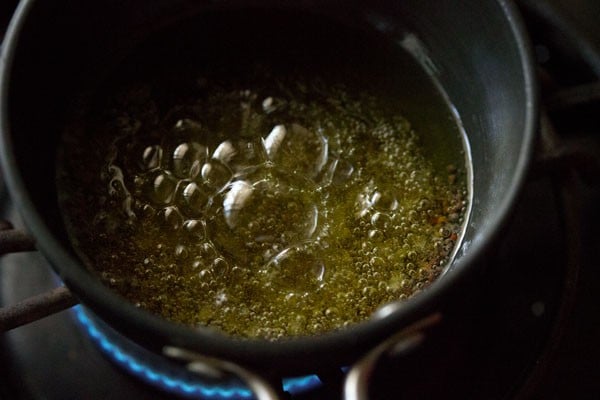
13. Then add 1 teaspoon cumin seeds.
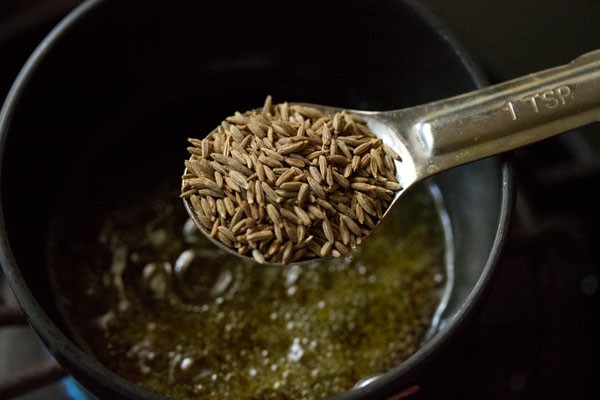
14. The cumin seeds will crackle as soon as you add them in oil. Let them change their color.
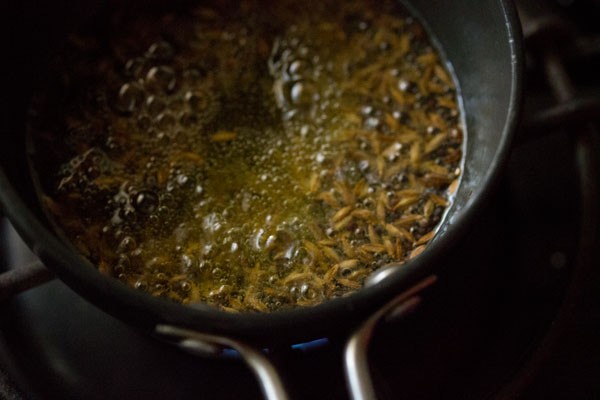
15. Then add 4 to 5 medium garlic cloves, crushed lightly with their peels on. You can also slice or chop the garlic. Fry for some seconds stirring often. The garlic can be a light golden but do not brown them or burn them.
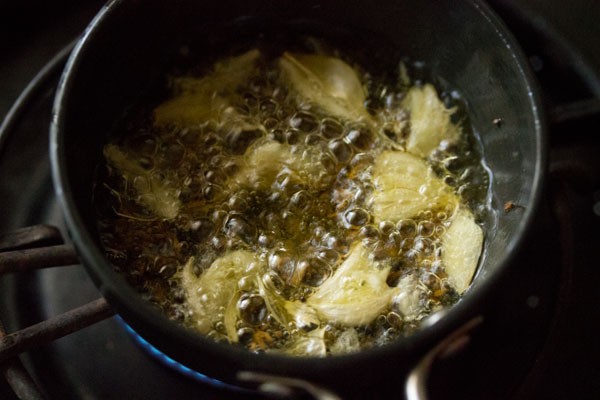
16. Add 1 to 2 dry red chilies (broken and deseeded).
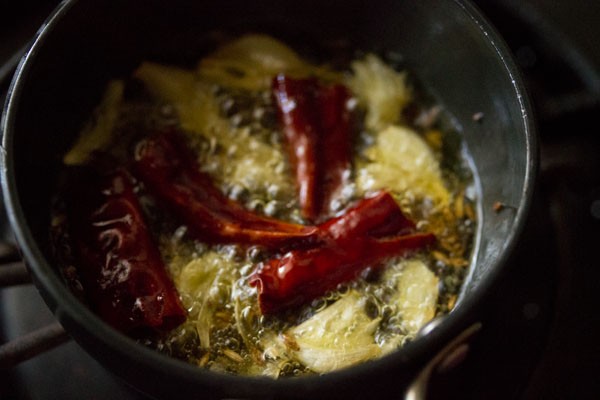
17. Add 9 to 10 curry leaves. fry for a few seconds till the red chilies change color and the curry leaves become crisp.
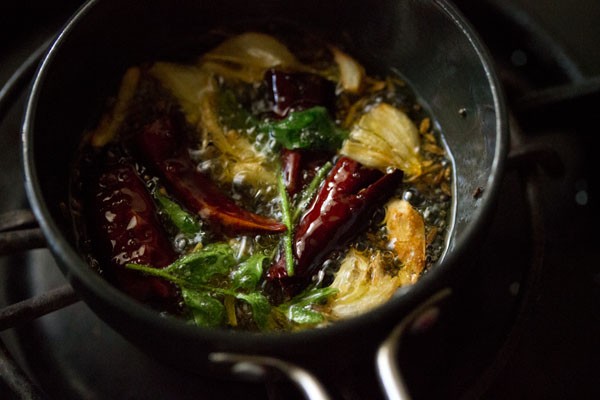
18. Pour the entire tempering mixture in the dal.
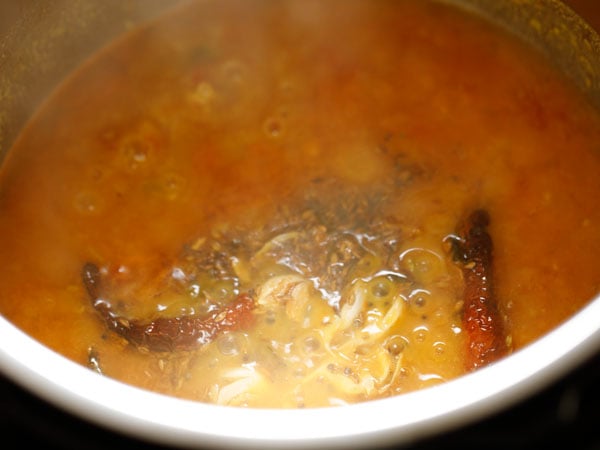
19. Mix very well.
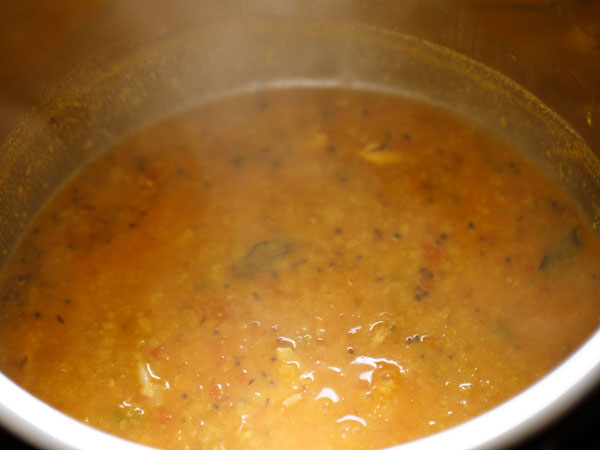
20. Lastly, add 2 tablespoons chopped coriander leaves (cilantro)
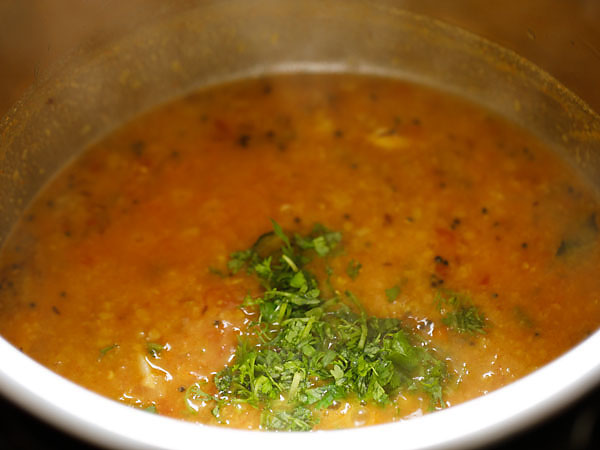
21. Stir and instant pot dal tadka with steamed rice or roti. You can garnish with some coriander leaves while serving.
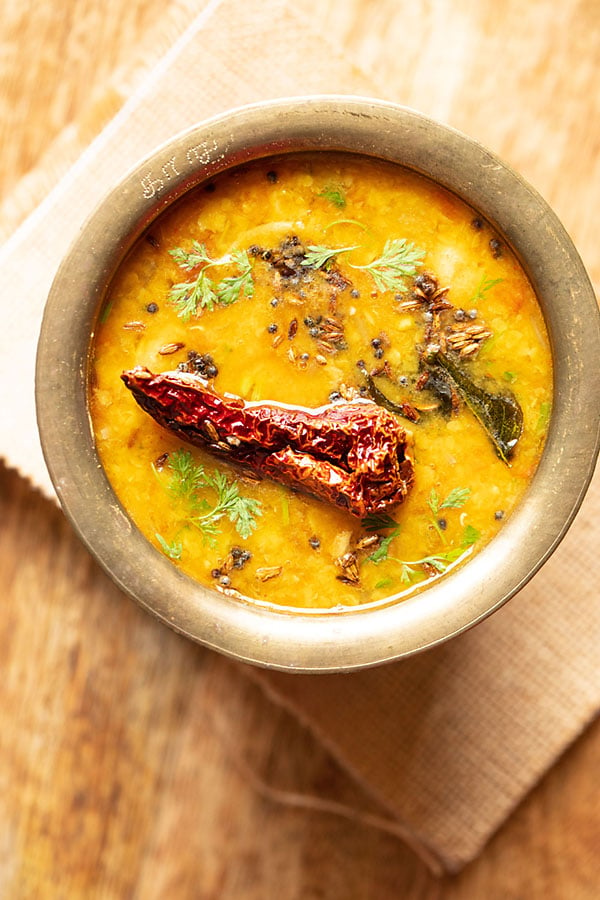
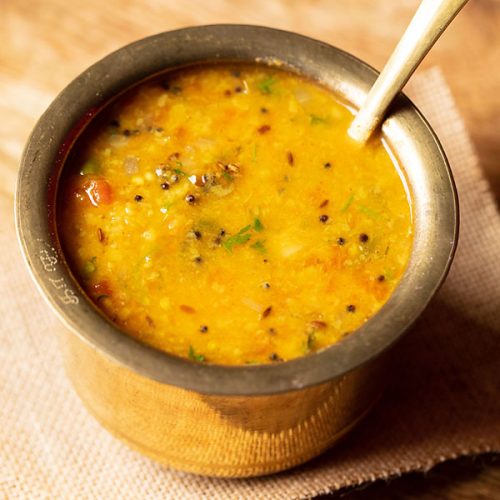
Instant Pot Dal Tadka
Ingredients
main ingredients
- ½ cup arhar dal or 100 grams arhar dal (tuvar dal or split pigeon pea lentils)
- ⅓ cup chopped onions or 1 small medium-sized onion or 50 grams onion – chopped or sliced
- ⅓ cup chopped tomatoes or 1 medium-sized tomato or 65 grams tomatoes – chopped
- 1 to 2 green chillis or serrano peppers – sliced, slit or chopped
- ¼ teaspoon turmeric powder (ground turmeric)
- ½ teaspoon kashmiri red chilli powder or ¼ teaspoon cayenne pepper or paprika
- 1 pinch asafoetida (hing) – optional
- 1.5 cups water
- salt as required
- 2 tablespoons chopped coriander leaves (cilantro) – for garnish
for tempering
- 2 tablespoon oil – ghee can be substituted in place of oil. use either sunflower or any neutral tasting oil
- ½ teaspoon small mustard seeds
- 1 teaspoon cumin seeds
- 4 to 5 medium-sized garlic cloves – sliced or chopped or crushed lightly with their peels on
- 1 sprig curry leaf or 9 to 10 curry leaves
- 1 to 2 dry red chilies – broken and deseeded
Instructions
pressure cooking dal
- Take the lentils in a bowl or colander.
- Rinse a couple of times and add the rinsed dal in the ip steel insert.
- Add sliced onions, chopped tomatoes, green chilies (sliced, slit or chopped), turmeric powder, red chilli powder and a pinch of asafoetida.
- Pour water. Mix well. Secure the lid and position the steam release handle to sealing.
- Press the pressure cook button and set the timer for 15 minutes on high pressure.
- Give npr (natural pressure release) of 10 minutes.
- Release the pressure after 10 minutes and open the ip lid. The lentils have to be cooked very well and become soft and mushy. With a spoon lightly mash the dal mixture.
- If the dal looks thick, you can add some hot water.
- Then season with salt as per taste and mix.
- Cover the cooked dal with the ip lid and begin with the tempering.
tempering (tadka)
- In a small pan or tadka pan, heat oil. Add the mustard seeds.
- Let the mustard seeds crackle. Then add the cumin seeds. The cumin seeds will also crackle and brown when you add them.
- Add 4 to 5 medium garlic cloves, crushed lightly with peels. You can also slice or chop the garlic. Fry for some seconds. Do not brown or burn the garlic.
- Add the dry red chilies (broken and deseeded), curry leaves. Fry till the red chillies change color and the curry leaves become crisp.
- Pour the entire tempering mixture in the dal. Mix very well.
- Lastly add chopped coriander leaves.
- Mix again and serve the dal tadka with steamed rice or roti. You can garnish with some coriander leaves while serving.
Notes
- Depending on the quality and age of lentils, the cooking time can vary from 10 to 15 minutes. I prefer the dal to be cooked really well and mushy without any separate grains visible, so I cook the lentils for 15 minutes. Thus depending on the quality of dal, you can decide upon the timing. Even if the lentils are undercooked, you can always pressure cook for some more minutes later.
- Asaofoetida can be skipped.
- To make a spicy dal, add more green chillies.
- If the dal has a thick consistency, add some hot water to thin it.
- If the dal consistency looks thin, press the sauté button and simmer for a few minutes.
- Add the rinsed lentils, chopped onions, tomatoes, green chillies, asafoetida, turmeric powder, red chilli powder in a 2-litre pressure cooker.
- Add 2 cups water.
- Pressure cook the dal for 8 to 9 whistles or 14 to 15 minutes. When the pressure comes down on its own, in the cooker, check the dal. The lentils have to be cooked very well and become soft and mushy.
- With a spoon lightly mash the dal mixture.
- Then add ½ to 1 cup water to the dal. You can add water as required depending on the consistency you want. For a thicker dal, add less water and for a thin dal, add slightly more water.
- Stir very well. Season with salt as per taste.
- Keep the dal on stove top and simmer for some minutes till you get the desired consistency. Do stir the dal at intervals so that the dal does not get browned or burnt from the base. Cover and keep aside.
- Later fry the spices and herbs in the oil and add to the dal.
- Add coriander leaves. Mix and serve.
- Soak the lentils for about 1 to 2 hours. Drain and rinse them well in water.
- In a deep pot, add 4 to 5 cups water added to the lentils. Add the rest of the ingredients mentioned in the recipe. Cover and cook the lentils.
- If the water begins to froth and bubble, then remove the lid or cover it partly and continue to cook the lentils till they become soft and creamy.
- If the water becomes less, then add some hot water. Once the lentils are cooked (takes from 45 mins to an hour or sometimes more. Depends on the quality of the lentils). Then follow the recipe further as mentioned above.
Nutrition Info (Approximate Values)
This recipe post is from the archives (July 2012) and has been republished and updated on 4 June 2020.
This post contains amazon affiliate links.
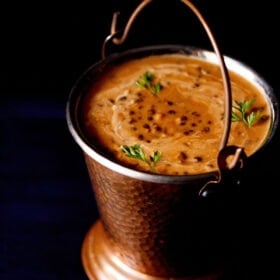
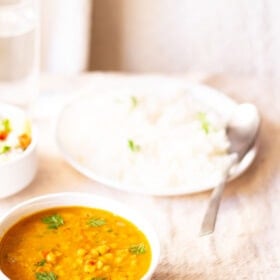
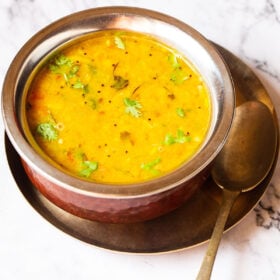
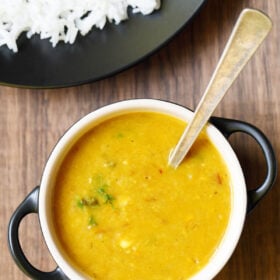
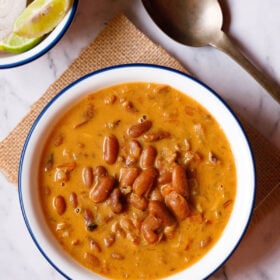
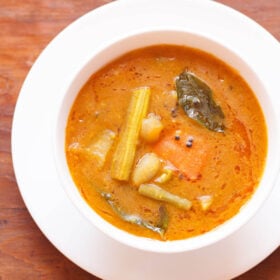








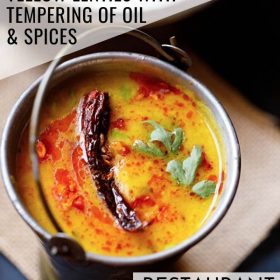
Tried your recipe and it was like Dhaba dhal. Thanks for sharing.
thanks nina
thanks yar. I’ve got what i want.
Hi there!
Learned a couple of new things here, thanks for sharing the recipe too! =D
thanks helene 🙂
Dassana, I do this and it is one of my favourites. I add small slit-green chillies to the tadka too and sometimes cannot resist the South India curry leaves! 🙂
this is a regular at our place shri. when i want south indian style, i add mustard and curry leaves to the tadka. even i add green chili sometimes.
M not getting ur mails, y so, since last week hav not received any mail
hi sonali. thanks for your concern.
i am on a small break. i will resume blogging in one or two days. my latest post of south indian mushroom biryani was almost drafted a week back and i still need to do some changes to it. you will start receiving the recipes mails in a day or two.
I very like dal indian tarka
hi dassana,
needs your help on the timings for cooking various dals. after a use of years pressure cooker whistles are not that good and then our estimate has to be time base…by the way the way I judge my dal timings are aroma…and they are almost 98% correct…even for rajma and both the types of chanas…but i want to know from you how to be 100% precise in dal making…
dal soaking and dal pressure cooking timings….are 2 aspects for what i am looking to you …
and as u say 4-5 whistles…means these on high flame or first high and then low
one more thing Dassana,
i am really poor in making basmati plain rice…it is a matter of chance that the rice turns good….i have tried ur other receipes and they for sure turns out good…please tell me methods to cook plain rice so that they come good everytime I cook …
there r several methods to cook rice too….by discarding boiled starchy water…..keeping the water retained..pressure cooker method …and patila method 😉
would like to know all the methods….
let me remind u …you have my one request already pending and today i have added two more to list….hoping to get ur guidance on all …and that too soon…..
…Dassana…ur blog has given me a platform to expertise in every recepie and I being fond of cooking don’t want to miss that opputunity………
thanks renuka for your positive comments.
i have seen and done with all methods of rice cooking. lets go one by one:
1: cooking in a pot or patila: this is one technique i make rice often with. i don’t pre soak rice unless the recipe calls for it like biryani or pulao etc. to make plain boiled rice, i just add the rice to the water. there ate 2 ways in this:
a: first you heat water and then add the rice.
b: you mix the rice and water and then keep it on the gas stove.
cover the pot and let the rice cook. in between you have to check the rice.
for this method i add 2 cups rice with 4.5 cups water.
2: pressure cooker method: here i add 2 cups rice with 4 cups water and then pressure cook the rice for 3-4 whistles on full flame. at home we prefer a little softer consistency so 4 whistles works fine for us.
3: by discarding the starchy boiled water: i have seen my mom making rice this way many times but i only made a couple of times. here we need to take 6-7 cups water for 2 cups rice. boil the water with salt first. then add rice. cover and let the rice cook. once the rice gets cooked, strain the water and fluff the rice.
4: one more method… that i make rice with when i run out of cooking gas 🙂 microwave method: here i add 2 cups rice with 4.5 cups water in a microwave safe container and microwave on medium power for 14-15 minutes.
5: lastly, i have also cooked rice in an electric cooker. this is the best. here i add 2 cups rice with 4.5 cups water. i don’t need to time anything here. when the rice is cooked the cooker stops. the rice stays warm for some hours and one doesn’t have any issues with reheating the rice etc.
one more important thing: when cooking basmati rice the proportion of rice to water can be 1:2 or 1:1.25 but for some other varieties of rice you may need to add more water.
a tip: adding some drops of oil or ghee to the rice helps the grains to stay separate.
i hope renuka, all these info on cooking rice helps you and also makes you a better cook. i think i should write a detailed post on the various methods of cooking rice.
thanks Dassana,
I will try pot and pressure cooker method and then let u know …how it worked
thank u once again
welcome
ok renuka here we go:
soaking dals: i generally don’t soak dals except for chana dal and whole moong beans. recently i read that soaking dal does not allow them to become mushy and soft. the grains remain separate.
pressure cooking dals: for 1 cup of masoor, arhar or moong dal, i add around 2 cups of water and pressure cook the dal. after pressure cooking on 4-5 whistles on full flame, i switch off the gas stove. i have a small cooker so it does not take much time for me to cook the dal. in a larger pressure cooker, it will take time for the steam to build up.
the dal gets well cooked and a little thick. i add some water to it later, to get the right consistency and let it simmer before adding the tadka/tempering to it.
while cooking dal, if the recipe calls for a soft consistency then you can overcook the dals. but if the recipe calls for separate lentils like a dry moong dal sabzi etc than you just cook the dal in 2-3 whistles.
generally i don’t keep a tab on the time whilst cooking dals or rice. i think 3-4 minutes are fine if you pressure cook the dal on a full flame. i agree with you that aroma of the dals does help in knowing if the dal is cooked or not.
i hope this info and the way i cook dals at home help you.
Hi Dassana,
thanks once again for all ur efforts….
Actually why i had taken this issue was beacause though my pressure cooker is working pretty fine but it does not give proper whistles …i have heard many times people working with dals as per timings…
Dassana…every night at home we have dal with rotis and we make various types of dals…let me list them
moong dhuli
moong dhuli + masoor
masoor
arhar
chana
moong sabut
masoor sabut
moth dal
urad chilka+ chana
urad dhuli
urad dhuli + chana
urad sabut ( mah ki dal)
moong chilka
moong chilka + chana
massor + urad chilka + arhar + moong chilka
Besides I cook also…..
kabuli chana
kala chana
rajma
lobiya ( rongi)
matar ( one used with kulcha i.e. matar kulcha…..even I want you to post that receipe…….me being fond of it but don’t have expertise in it…..I am sorry for being too demanding …Dassana )
I doubt that moong sabut dal will be done in 3-4 whistles or u mean half split i.e. moong chilka …moong chilka may be done in that time..
Once again thanks for being so patient in reading my long mails…
no issues renuka. we also cook dals for dinner.
when i said moong dal, i meant moong chilka. spilt moong dal takes the shortest time to cook than other dals.
the following rule you can apply:
1: skinned and split lentils or split lentils with skin like
arhar, masoor, urad dal: 4-5 minutes
moong dal: 3-4 minutes
presoaked chana dal: 5-6 minutes
2: whole lentils like whole moong, whole masoor which are pre soaked: 5-7 minutes
3: legumes like presoaked rajma, dried matar: 8-10 minutes
presoaked kabuli chana, black chana: 7-9 minutes
presoaked dry white or green peas/matar – 9-10 minutes
presoaked lobiya or moth beans: 6-8 minutes
I hope this helps.
i LOVE that spoon and the copper pot is amazing. so beautiful!
i like to add my idea in your dal ………….boiling the dal with onion is good ,but i like to add ginger garlic and chily after we mix dall well ,so the fresh flavor of chilly ginger does not get lost by over boiling dal in cooker .for me………….dry methi if i put it in dal straight it release the bitter flavor but if i add in tadka…….generous amount it release aromatic flavour.i like spices to go in oil in order for the best and not burnt flavour……first always mustard seed till they pop up >hing start browing>whole red chily start turning dark for smoky flavour>now garlic turning golden some chopped chily>khadi patta >jeera remove from heat > methi leaves>sesame seed ,pour over dal ,add lots if chopped coriander stems only , for bursting flavour,no leaves .stems will release flavour with heat,while leaves will cook and taste bitter,so add just before serving. thank you for sending lots of recipes .
thanks hemlata for your suggestions and tip. i will surely try adding kasuri methi to the tadka. i always add it to the cooked dal.
basically i do not add chili powder to the tadka coz i don’t like the burnt chili flavor.
the idea of adding sesame seeds & coriander stems is unique as well. i will try making tadka the way you have suggested.
just made this…….spot on……i could eat this everyday!…..maybe a little more tomato 🙂
thanks thomas for trying the recipe 🙂
Yum!!!!! I would love to eat this right now 🙂
Very tempting
looks wonderful deliciously done lovely picture
thanks
Dal tadka is comfort food for me… all I need is some dal chawal to lift my spirits up on a sad day…
ohh how I miss having dal regularly, my husband and in-laws are not at all dal people… They need there daily fix with a yoghurt based gravy- Moru… I’m just too lazy to make an extra dish just for myself… But I do make it once in a while to treat myself… I want to try this recipe next time coz I have never used kasuri methi in dal… I always add tomatoes I love the tang it gives…
in my home everybody are dal people. they just love dals. i like moru too.
kasuri methi gives the dal a good aromatic edge and makes it very much like the dals served in the restaurant. mostly the dals that we get in restaurants have kasuri methi added to them.
You post lovely recipes which are simple to make. Thanks for sharing…will try this dal. Love this tadka dal
do try rujuta. this is a very good dal tadka. you can even add your choice of ingredients to the tadka.
This Dal tadka reminds me of dhaba food in Amritsar….Amazing pictures as usual!